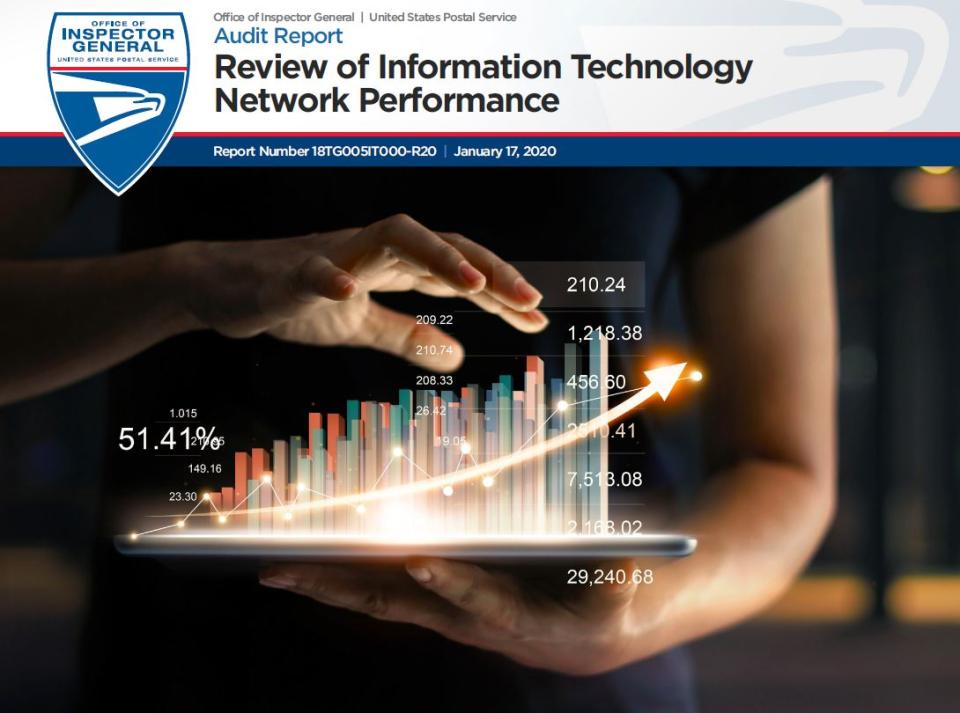Review of Information Technology Network Performance
Objective
Our objective was to determine if the U.S. Postal Service’s network performance is optimized to support infrastructure demands and ensure system availability.
The Postal Service operates and maintains one of the world’s largest computer networks, linking more than 31,000 retail locations and making communication possible among hundreds of thousands of employees. The Postal Service processes more than 146 billion mailpieces annually and delivers nearly half of the world’s mail. To do this, the Postal Service relies on about 86,000 network devices that support the Information Technology (IT) and mail processing infrastructures.
As the Postal Service invests in IT infrastructure to meet the changing needs of its customers and remain relevant in the digital future, an optimized network is the foundation for achieving its strategic and future ready goals.
To evaluate the overall performance and efficiency of the network, we assessed IT segments that support the four largest mail processing facilities, the primary data center, and a pilot location used for a mail processing infrastructure redesign. We also evaluated the Postal Service’s network inventory system that accounts for the network devices and the network diagrams that show the relationship between these devices to understand the architecture, its connectivity, and the potential impact of changes.
Findings
The Postal Service IT network is not fully optimized to meet future requirements. While the network handles current operational requirements, performance and system availability should be improved for the future.
Management did not establish enterprise-wide performance metrics and improvement targets for optimal network performance and operating efficiency. For example, the Sacramento Processing and Distribution Center (P&DC) experienced 51 network connectivity issues that resulted in additional manual mail processing costs of over $1.1 million from the period of December 2017 through June 2019. In addition, the facility was missing critical system controls, such as backup generators and properly configured network devices to ensure uninterrupted service. Monitoring against enterprise-wide performance metrics and improvement targets could have helped prevent these service disruptions.
We also found instances where the Postal Service did not upgrade the network’s bandwidth for circuits that exceeded their recommended capacity at mail processing and other key facilities. We assessed six sites from November 2017 through December 2018 and leveraged data from the Postal Service vendor’s bandwidth utilization reports to determine circuits that should be upgraded. We found bandwidth utilization issues at three facilities. For example, circuits at the Kansas City P&DC were running above the Postal Service’s recommended capacity for over a year.
Further, we found the Postal Service’s IT network diagrams and inventory system were not sufficient to efficiently manage and operate the enterprise network. For example, the [redacted] had a [redacted] not represented on their network diagrams. [Redacted.] Also, inventory records were not always accurate. We identified about 1,900 devices that were not accounted for in the inventory system. The inventory records also contained 1,730 duplicate internet protocol addresses, 2,697 duplicate hostnames, 3,458 missing serial numbers, and 3,333 missing device models.
As the Postal Service moves into the digital future, an understanding of the existing network and its architecture is essential to consistently meet customer needs. Left uncorrected, the Postal Service will not have the necessary information available to identify [redacted], understand the impact of architectural changes, and minimize downtime to troubleshoot network issues and avoid incurring additional manual processing costs. Without performance metrics, the Postal Service cannot determine if systems operate within desired parameters. Further, the Postal Service’s IT network is at risk of experiencing sub-optimal network performance, resulting in potential disruptions to mail operations.
Recommendations
We recommended management:
- Establish a network strategy to include a process to continuously monitor the information technology network and develop enterprise-wide performance metrics and improvement targets.
- Implement a solution, such as use of sitewide emergency generators, to prevent network connectivity issues and adjust the configuration settings of network devices at the Sacramento Processing and Distribution Center.
- Develop an automated process to regularly review vendor bandwidth utilization reports and upgrade bandwidth when it exceeds determined thresholds.
- Develop and maintain detailed Postal Service information technology network diagrams.
- Perform a manual review of the automated inventory process on a periodic basis and update the inventory data accordingly.

